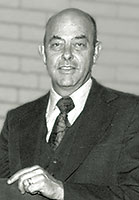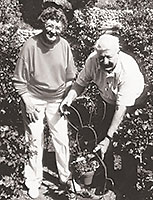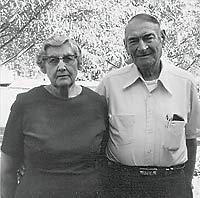 |
| Samuel John Taylor – “One of the things I’ve always liked about Moab, even back in the 40s, was that it was very open and welcoming to new people.” |
At some point most of us study history through dates, names, and big events. But what happens to the stories of individuals that lived to tell about those times? By recording oral history interviews, we are in fact preserving the chronicles of individuals that might otherwise be lost. The recollections of interviewees—personal anecdotes, observations, timelines, eyewitness accounts, and facts of everyday life—capture the essence of the earlier days and paint a far more intriguing picture of the past. Moab Museum’s collection of 31 oral histories are now available online so that we can get to know folks who left their mark in ways that no other documents or public records can capture.
 |
| Maxine Newell – “Before I worked for the Park I worked for the local newspaper for six years and I remember going out there [Arches] one time and they were celebrating their first 100,000 visitors for all times.” Shown with Maxine’s friend George Anderson. |
The 2003 oral history of Samuel (Sam) John Taylor was told to Rusty Salmon, managing editor of Canyon Legacy from 2000-2005. Sam, the son of Loren L. “Bish” Taylor, is the great-grandson of Norman Taylor, an 18-year old wheelwright on the 1847 Brigham Young wagon train. After Sam got out of the service in the mid-50s, took over the Moab Times-Independent, then finished his journalism degree, he married and, “…had been given 2 acres of ground by my father for partnering with him on his little 15-acre farm to plant a thousand peach trees. I did all the work. Did all the harvesting, did all the pruning. He paid the taxes, he bought the tractor, he paid the irrigation bill, and we split the peach crop.” That farm was located on the northwest side of town at Palisade and Westwood.
The field of oral history is somewhat new due to information technology available for capturing the spoken or oral tradition. In the case of our oral history collection, participants agreed that their transcripts be made public by including them in the Grand County Historical Preservation Commission and the Utah Historical Society archives. For families of ancestors that participated, the stories became part of their precious family heritage. And because of their historic value, the oral history collection is a large part of how the Museum presents our region’s past to locals and a world of visitors.
 |
| Edd and Isabelle Provonsha – Edd and Isabelle Provonsha – Their history was written in 1978 by Isabelle. When she was one month old she went on her “first horseback ride” from Moab to Paradox, Colorado where her grandparents lived. |
Telling the story of her time with the National Park Service, Maxine Newell’s interview was conducted by Amy Korpieski on July 1, 1991. Maxine worked at Arches National Park from 1968 until her retirement in 1985. Since there were only three staff members at the time, her “Park Technician” job was diverse: secretarial work, interpretive writing, and managing the museum, library, and historic files. She didn’t go out on rescue searches, though. “I did the radio for searches and it was one great experience.
 |
| Merv Lawton – Merv was born in Cape Town, South Africa in 1922, was educated there until university, but because of WWII he joined the South African Air Force, then “seconded” to the Royal Air Force. His is a fascinating story. |
There is nothing more thrilling than ‘all is well’ when they have found whoever they were looking for. One time they called me out at two o’clock in the morning, had me stop for 50 ham sandwiches, and we kept in touch with Park rangers by radio. Finally they called other people – the Grand County posse, the sheriff’s posse – out to help.” A park ranger’s son was lost but the helicopter they sent out at daylight found the injured hiker and returned him to the Visitor Center before the posse had a chance to go out. “Well, that was a celebration. We all ate ham sandwiches for breakfast.”
These are stories not to be found in history books. Discovering people and places through the reading or hearing of oral history interviews makes the past become alive and relevant to understanding the present. Even though most of our historic photos are in black and white and recordings of stories may sound dated and aged, the voices and experiences of those who came before us were just as clear, colorful, and real as yours and mine. Get to know some real locals as they remember their own past. Visit: moabmuseum.org/oral-histories, and become a member to help support the Museum.
Moab Museum
Downtown Moab, 118 East Center Street
moabmuseum.org • 435-259-7985
|